CHAPTER 1
INTRODUCTION
1 Introduction
Digital technology is increasingly important. Its economic, societal, and political impacts are unprecedented. At the same time, it is increasingly challenging for digital practitioners to design, develop, run, and support the systems and services that fulfil this demand. ITIL® 4: High-velocity IT focuses on digital products and services, including digital customer experiences, covering good organizational practices and mental models, all from a practitioner’s perspective.
This publication is aimed at IT and service management practitioners who work in organizations that are becoming more digitally enabled. It will help those who are familiar with traditional IT and service management concepts to discuss ‘digital’ confidently, develop practical competencies, and integrate new concepts, techniques, and technologies into their ways of working.
You should use this publication as a tool to improve how you and your co-workers:
• provide products and services
• continually raise your standards of work
• trust and are trusted
• accept ambiguity and uncertainty
• commit to continual learning.
This publication’s scope includes the primary activities in the digital value chain, including what the practitioner does and the resources they use across the lifecycle of digital products to:
• make the right digital investments
• realize and deliver resilient digital products and services quickly
• ensure that the service consumer realizes value from those products and services
• assure the conformance of activities with governance, risk, and compliance requirements.
Technological progress, combined with innovatively applied digital technology, has resulted in systems that are complex and unpredictable. Systems now comprise a multitude of components produced by parties who act with varying degrees of dependability, leading to intrinsic fallibility and flaws. Continual changes to a system and its environment mean that these flaws also continually change. Most are too small to cause significant issues, either because of redundancy and other forms of resilience in the system, or because of human intervention.
In the past, most people believed that change disrupts stability, and stability controls change; fewer changes meant less risk to stability. In the past decade, a different way of thinking has been adopted. By reducing the size of change, the risk of disruption is reduced. Smaller, more frequent changes improve the organization’s capability to change, thereby lowering the risk of disruption. Recently, the prevailing approach has been to embrace and enable changes.
All of this has changed the environment from ‘causal’ (if-then-else), predictable models to dispositional (if-then-maybe) ones. Because system behaviour cannot always or easily be predicted, ways of thinking and working shift: from prediction and control to insight and understanding; from large, occasional changes to small, frequent ones; from detailed planning in advance to continually experimenting and learning; and from failsafe to safe-to-fail. These are not trivial shifts.
In addition to this increase in complexity-based ways of thinking and working, breaking down silos, or at least silo-thinking, is a current concern. Homogeneous groups are less resilient and effective than diverse ones. In an organizational context, this means that specialists, teams, departments, and organizations should embrace opportunities to work with a wide range of people.
Fortunately, many things are changing. People are working effectively in small, product- or service-oriented teams. Automation is used more often to support IT processes. The interrelated concepts of immutable servers and infrastructure as code are widely adopted. Holistic systems thinking is more prevalent. Scientific thinking is being adopted. Unpredictability and ambiguity are increasingly accepted as necessary. There is a shift from a mentality of delivering value to one of co-creating value. External services are often acquired and integrated for fast development of digital capabilities, as either an alternative or an addition to the internal Agile approach.
These changes are manifestations of new ways of thinking and working that are becoming mainstream. ITIL® 4: High-velocity IT builds on these developments, and contributes to them. Among the topics discussed in this publication are:
• the ethical considerations relevant to digital technology
• design thinking
• working in complex environments
• the ITIL continual improvement model
• Lean culture
• safety culture
• Lean, Agile, resilient, and continuous techniques.
